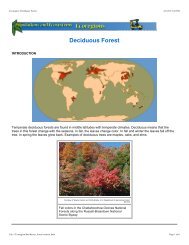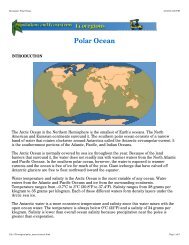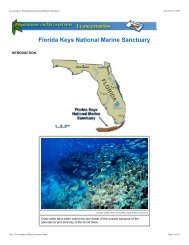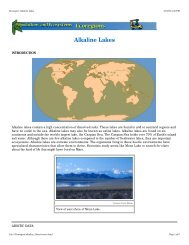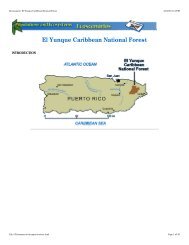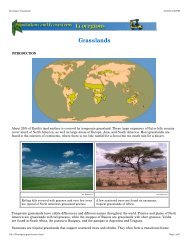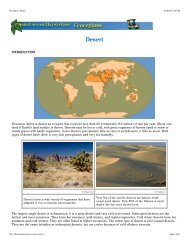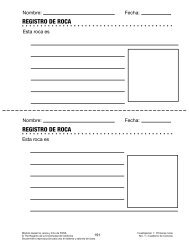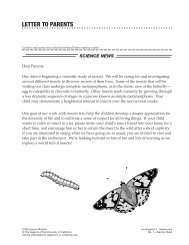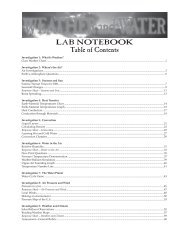Ecoscenarios Combined - FOSSweb
Ecoscenarios Combined - FOSSweb
Ecoscenarios Combined - FOSSweb
Create successful ePaper yourself
Turn your PDF publications into a flip-book with our unique Google optimized e-Paper software.
Ecoscenario: Monterey Bay National Marine Sanctuary<br />
4/16/03 3:22 PM<br />
BIOTIC DATA<br />
Monterey Bay National Marine Sanctuary is dominated by the ecosystem called a kelp forest. The trees in this forest are<br />
actually species of algae commonly known as kelp. In Monterey Bay National Marine Sanctuary there are two dominant<br />
kinds of kelp. The more common species is giant kelp. It prefers sites with calm water where each individual kelp can live<br />
for up to 10 years. Giant kelp can grow as much as 0.6 meter (2 feet) a day when it gets enough light. The other species<br />
is bull kelp.<br />
It grows mostly in exposed areas with plenty of water motion. It has an annual life cycle. Because these kelp<br />
prefer different amounts of water motion, giant kelp might be more abundant in calm years, while bull kelp would dominate<br />
in years with rough surf.<br />
Like forests on land, kelp forests need sunlight. They grow in the photic zone. Kelp forests usually are found in water<br />
between 2 and 30 meters (6 and 100 feet) deep. Also, like terrestrial forests, kelp forests have patterns of seasonal<br />
growth. In the spring, juvenile kelp grow quickly. By summer, there is a lush canopy of kelp. In the fall, growth slows, and<br />
the kelp fronds become ragged and torn, partly because of the invertebrates that feed on them. In the winter, when the surf<br />
is higher, kelps tear loose from the ocean floor. Giant kelp grows very slowly in the winter, and bull kelp dies.<br />
Kelp requires cold temperatures to reproduce sexually, which starts the cycle over each year. During El Niño years,<br />
however, the temperatures are higher than normal, so the kelp may not be able to reproduce. For giant kelp, this results in<br />
older, more fragile kelp throughout the kelp forest during the following year. Bull kelp would die back completely if it could<br />
not reproduce.<br />
Courtesy of Monterey Bay National Marine Sanctuary<br />
Kelp continues to grow up to 0.6 meter (2 feet) per day after<br />
reaching the water surface. The fronds form a dense mat along<br />
the surface.<br />
The kelp forest can be divided into layers that support different communities of organisms—substrate, midwater, and<br />
canopy. The substrate layer is at the bottom, where the kelps are attached to rocks with rootlike structures called<br />
holdfasts. Abalones, bat stars, brittle stars, and sea urchins are a few of the animals found in the substrate layer.<br />
Lobsters and hermit crabs hide in the rocks and scavenge for bits of detritus.<br />
The midwater layer is where the leaflike fronds of kelp are suspended in the water. Turban snails and purple-ringed top<br />
snails cruise up and down the fronds in search of food. Fish, such as garibaldi, sheepheads, and giant kelpfish, swim<br />
among the fronds. The señorita fish's slender body is easily camouflaged by the kelp fronds. Kelp crabs climb up and<br />
down the kelp stipe, adding bits of kelp to their carapace for camouflage.<br />
file:///Ecoscenario/monterey/content.html<br />
Page 8 of 14



